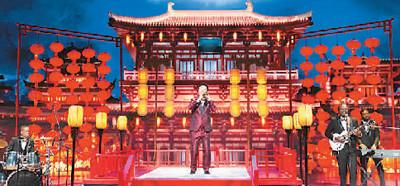
Chen Libao (center) performed "Birds and Phoenix" with a foreign band. Courtesy of the producer
"Awakening the Lion of the South China Sea" with the music of dragon boats supplemented by the posture of lion dance, "Saibei Jiangnan", which combines the northwest flowers and Yangzhou minor tunes, followed Oh Na to the Silk Road to explore the bustling "Hundred Birds and Phoenix"... On January 25, the Lunar New Year, with the theme of "Rhyme from the East, Music to the Future", the "New Folk Music National Wind Night" evening party was broadcast on Henan Satellite TV and Youku Tv Network. Jointly produced by Youku, Henan Satellite TV and Shrimp Music Entertainment, and co-planned and produced by Xinlefu in March, the party innovatively launched 15 programs, including 15 kinds of ethnic instruments such as pipa, Zhongruan, Dongbula, Guzheng, bamboo flute, gourd silk, erhu and karma drum by combining Chinese folk music with popular music, opera, poetry, martial arts, dance, intangible cultural heritage and other forms.
"In recent years, many creators and singers are actively exploring Chinese element music, and more and more musicians are returning to traditional culture, especially traditional ethnic instruments. In fact, whether it is Chinese instruments or Chinese music, there is still a lot of content that can be tapped in the traditional field. In such a traditional festival, we especially hope to present these new explorations to everyone. Yin Liang, the director of shrimp music entertainment and the chief producer of "New Folk Music National Wind Night", told reporters.
"New Folk Music National Wind Night" is the first party launched by Damai after the establishment of the shrimp music entertainment label, when mentioning the original intention of launching this party, Li Jie, president of Damai and producer of "New Folk Music National Wind Night", said that in Chinese music creation, the market needs to create a new realm and stimulate new energy in inheritance. He believes that with the continuous enhancement of Chinese cultural self-confidence, literary and artistic works based on local culture, excavating the essence of national culture, and integrating various artistic disciplines and various forms of expression will be more loved by the audience.
According to reports, "New Folk Music National Wind Night" takes the new expression of traditional Chinese music culture as the core intention, inviting well-known folk music players such as Feng Mantian, Chen Libao, Zhao Xiaoxia, as well as actors and students from the Central Chinese Orchestra, Beijing Chinese Orchestra, Central Conservatory of Music, China Conservatory of Music, Beijing Minzu University and other professional colleges and universities to form a folk music team, integrating folk music with electronic, reggae, hip hop, rock, folk songs, etc., forming a musical style with diverse styles.
Take "A Hundred Birds and a Phoenix" as an example, which was originally a famous song popular in the Central Plains, and expressed a vibrant natural scene with a passionate melody and the sound of birds and a song. In this evening, the bold integration of reggae music makes the original complicated passages not at all lengthy, but highlights a playfulness. Under Chen Libao's interpretation, the original slightly noisy texture of The Na is like a bird circling in the sky, with the back-beat of reggae music and the low rhythm of the trombone, jumping up and down, jumping and chirping among the trees, rich in layers and fluent in expression.
In "Saibei Jiangnan", a northwest flower "Little Six Children's Lotus Order" and the Yangzhou minor tune full of Jiangnan style completed a north-south dialogue. Sanxin and pipa, Gansu dialect and Wu Nong soft language, two distinctive folk music languages and cultural forms, use the beautiful emotions of inner narration as the medium, and build a framework through electronic music, coupled with DiXiao and Chinese percussion, to achieve seamless docking in hearing. Regardless of the words, songs, and artistic conceptions, they are all smooth and natural, one moment the yellow sand in the north of the sea, and the other time the green shade of the south of the river, just like a pair of long-distance lovers telling each other their heartfelt feelings.
"Chinese folk music has always been the most open, with a strong gene of hai na bai chuan. Our chants, yangqin, transverse flutes, guzheng, and zithers were all foreign instruments at the earliest. We take these instruments, the music, for my use, and then we export them. Today, with the enhancement of China's national strength, Chinese folk music should maintain this open and confident mentality, which is one of the reasons why we invite so many professional performers to do cross-border performances. Lu Zhongqiang, music director of "New Folk Music National Wind Night", said. He said that he hopes that through this evening, more young people can see the possibility of Chinese folk music in addition to gentleness and delicacy, and further activate the creative and performance ecology of folk music.